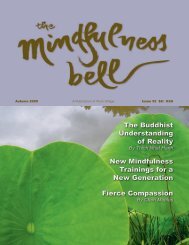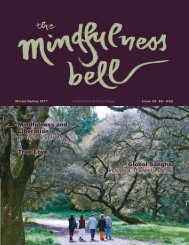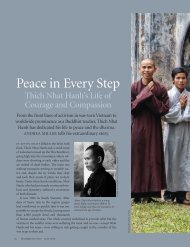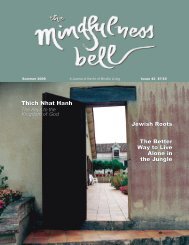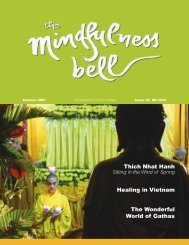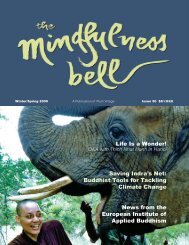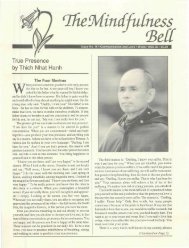View full issue in PDF - The Mindfulness Bell
View full issue in PDF - The Mindfulness Bell
View full issue in PDF - The Mindfulness Bell
- No tags were found...
Create successful ePaper yourself
Turn your PDF publications into a flip-book with our unique Google optimized e-Paper software.
dhar ma TALK<br />
M<strong>in</strong>dfulness tra<strong>in</strong><strong>in</strong>gs, the fourth paramita, are characterized <strong>in</strong><br />
the Eightfold Path by right speech, right action or conduct, and right<br />
livelihood. <strong>The</strong> first role of the m<strong>in</strong>dfulness tra<strong>in</strong><strong>in</strong>gs is creat<strong>in</strong>g stability<br />
and safety <strong>in</strong> and around ourselves. You know, it is very difficult to<br />
reach tranquility and profound <strong>in</strong>sight <strong>in</strong> sitt<strong>in</strong>g meditation if you’re<br />
constantly look<strong>in</strong>g out the w<strong>in</strong>dow to see if your neighbor is look<strong>in</strong>g<br />
for you with a gun because you stole his chicken! [Laughter] <strong>The</strong> first<br />
function of virtue is to create stability <strong>in</strong> ourselves, so we can calm<br />
down. So the sand <strong>in</strong> the glass can settle at the bottom.<br />
M<strong>in</strong>dfulness tra<strong>in</strong><strong>in</strong>gs are the ground upon which awaken<strong>in</strong>g can<br />
occur. And they are also evidence of the awaken<strong>in</strong>g. <strong>The</strong>y’re both. But<br />
it’s a journey. <strong>The</strong> first step <strong>in</strong> practic<strong>in</strong>g the m<strong>in</strong>dfulness tra<strong>in</strong><strong>in</strong>gs is<br />
to notice your own behavior. Not improv<strong>in</strong>g yourself. <strong>The</strong> first step is<br />
notic<strong>in</strong>g yourself with gentleness, with compassion. And the second<br />
step is slowly beg<strong>in</strong>n<strong>in</strong>g to try to shift the pattern. <strong>The</strong> third step is<br />
heal<strong>in</strong>g the pattern. And the fourth step is transform<strong>in</strong>g the pattern.<br />
Most of us want to go from step one to step four. Be compassionate<br />
with yourself. <strong>The</strong> key is to cont<strong>in</strong>ue to practice. M<strong>in</strong>dful breath<strong>in</strong>g,<br />
m<strong>in</strong>dful walk<strong>in</strong>g, m<strong>in</strong>dful eat<strong>in</strong>g.<br />
<strong>The</strong>re’s also a secret of the Eightfold Path that’s not written<br />
down. It’s called right association. Dur<strong>in</strong>g a retreat last summer one<br />
of the children asked Thay, how did he get so peaceful And Thay<br />
said, “Well, first I wanted to be peaceful. Second, I had an image of<br />
what that might be like.” And he referred to a time when, as a young<br />
person he saw his first picture of the Buddha sitt<strong>in</strong>g m<strong>in</strong>d<strong>full</strong>y on the<br />
grass. “Third, I surrounded myself with peaceful people. Fourth, I<br />
added to that an environment that would support my practice of peace.”<br />
Right association.<br />
Many of us want<br />
more peace, but our<br />
associations are not<br />
peaceful. We have<br />
to take charge, and<br />
create the environment<br />
that cares for<br />
us, that supports us,<br />
that will susta<strong>in</strong> us <strong>in</strong><br />
becom<strong>in</strong>g real human<br />
be<strong>in</strong>gs. We have to<br />
learn to set boundaries<br />
that protect our<br />
practice. We have to<br />
learn to protect ourselves<br />
from others<br />
with gentleness and<br />
k<strong>in</strong>dness, with k<strong>in</strong>d<br />
car<strong>in</strong>g.<br />
Meditation is<br />
the fifth paramita that<br />
takes us to the other<br />
shore. And the other<br />
shore is always right<br />
here, right now. <strong>The</strong><br />
practice of meditation<br />
is not an escape<br />
from life, it’s an escape<br />
<strong>in</strong>to life. <strong>The</strong> classical description of meditation is the practice<br />
of stopp<strong>in</strong>g, calm<strong>in</strong>g, and achiev<strong>in</strong>g tranquility, stillness of m<strong>in</strong>d,<br />
imperturbability. And the practice of deep see<strong>in</strong>g, deep look<strong>in</strong>g <strong>in</strong>to<br />
life, vipassanya, <strong>in</strong>sight. This must occur for that to occur, and of<br />
course they <strong>in</strong>ter-are, as Thay would say. But most of us want <strong>in</strong>sight<br />
without stopp<strong>in</strong>g, without calm<strong>in</strong>g. For example it’s not that we aren’t<br />
smart enough to solve the problem of education <strong>in</strong> America, it’s that<br />
we haven’t meditated on it. We haven’t stopped long enough to settle<br />
down, to calm ourselves, and to look deeply <strong>in</strong>to it.<br />
Sometimes at Plum Village Palest<strong>in</strong>ians and Israelis gather together.<br />
Because the first part of the peace process is about peace with<br />
oneself, they’ll spend several days sitt<strong>in</strong>g and walk<strong>in</strong>g and eat<strong>in</strong>g m<strong>in</strong>d<strong>full</strong>y,<br />
and only later will they start to talk about peace with each other.<br />
It’s only a political problem because it’s a spiritual problem.<br />
E<strong>in</strong>ste<strong>in</strong> said the same level of consciousness that created a<br />
problem can’t solve the problem. You can only re<strong>in</strong>force the problem<br />
with that k<strong>in</strong>d of th<strong>in</strong>k<strong>in</strong>g. It’s astound<strong>in</strong>g what can happen through<br />
spiritual practice, when, eye-to-eye across the table, father-to-father,<br />
son-to-son, daughter-to-daughter, mother-to-mother, all of a sudden<br />
we see each other’s children ly<strong>in</strong>g <strong>in</strong> the street and we get it! We get<br />
it <strong>in</strong> the very cells of our body, the possibility of be<strong>in</strong>g a real human<br />
be<strong>in</strong>g, and we know real human be<strong>in</strong>gs are not warmongers, that real<br />
human be<strong>in</strong>gs are not driven by revenge and prejudice. Revenge and<br />
prejudice and war are dark clouds float<strong>in</strong>g across the sky of a real<br />
human be<strong>in</strong>g.<br />
Meditation: stopp<strong>in</strong>g and calm<strong>in</strong>g and look<strong>in</strong>g deeply <strong>in</strong>to life.<br />
Meditation: sitt<strong>in</strong>g and walk<strong>in</strong>g and eat<strong>in</strong>g and ly<strong>in</strong>g down. Meditation<br />
is more than stress reduction. <strong>The</strong> purpose of meditation is to transform<br />
the quality of our m<strong>in</strong>ds. We say we want peace <strong>in</strong> the world, but we<br />
don’t have m<strong>in</strong>ds capable of it. We wish people were more k<strong>in</strong>d, but we<br />
don’t tra<strong>in</strong> our m<strong>in</strong>ds to be more k<strong>in</strong>d. Master Tang Hoi from Vietnam<br />
used to say that meditation is the process, the practice, of elim<strong>in</strong>at<strong>in</strong>g<br />
those clouds <strong>in</strong> the blue sky that is our m<strong>in</strong>d.<br />
Right view, right understand<strong>in</strong>g, is paramita number six. <strong>The</strong><br />
realization of perfect understand<strong>in</strong>g is the bodhisattva’s only career.<br />
It’s very important that all these practices are done with wisdom. Generosity<br />
without wisdom, without understand<strong>in</strong>g, is pity. Generosity<br />
without right understand<strong>in</strong>g means you’ve died for the wrong cause.<br />
History’s <strong>full</strong> of examples of that tragedy.<br />
Right view is detachment from views. It doesn’t mean we don’t<br />
have views. It means when we have views we know that that’s what<br />
they are, just views. Op<strong>in</strong>ions are easy to come by; most of us have<br />
op<strong>in</strong>ions that are created by our culture. We have op<strong>in</strong>ions created by<br />
our family, by our ancestors, about ourselves and about each other, and<br />
we th<strong>in</strong>k they are our own. Right view is <strong>in</strong>sight. Right view, right<br />
understand<strong>in</strong>g, is about mov<strong>in</strong>g from the shore of speculation <strong>in</strong>to the<br />
shore of direct perception. To practice develop<strong>in</strong>g <strong>in</strong>sight <strong>in</strong>to life,<br />
our whole life long,<br />
<strong>The</strong> way of the bodhisattva is the way of the real human be<strong>in</strong>g. It<br />
is the way, as Thay would say, of walk<strong>in</strong>g with our Buddha feet, so that<br />
with every step we enjoy the miracle of be<strong>in</strong>g <strong>in</strong> the present moment.<br />
We touch the Pure Land of the Buddha, the K<strong>in</strong>gdom of God with<br />
every step–that’s where we live. With our Buddha eyes, everywhere<br />
we look we see wonder.<br />
24 Summer 2004



